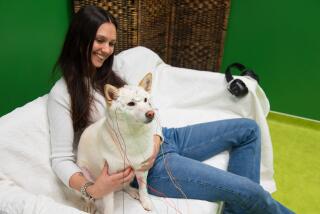Fluid dynamics on four legs: The brilliance of how dogs drink
The next time your dog heads to his bowl for a drink, take a second to appreciate his mastery of fluid dynamics as he laps up gulp after gulp. Don’t mind the mess he’s probably making -- it’s all part of his brilliance.
When your dog plunges his snout into his water bowl, it looks as though he’s scooping the water up with his tongue, like a ladle. And that’s what scientists used to think, until X-ray imaging showed most of that scooped-up water never makes it into your pup’s mouth.
In fact, there’s an impressive amount of physics and clever timing behind the way dogs drink, a new study reveals.
See the most-read stories in Science this hour >>
A dog laps by splashing its tongue into the water. As the tongue flies back, water sticks to the front of the tongue and gets pulled up toward the mouth. At just the right moment, the dog expertly snaps its jaws shut.
Lap. Gulp. Repeat.
“Dogs tend to be messy drinkers and splash water on themselves and the floor,” according to the study, published this week in the Proceedings of the National Academy of Sciences. But despite appearances, dogs are quite efficient drinkers.

Sunghwan Jung of Virginia Tech and colleagues examined the drinking behavior of dogs. (Sean Gart, Jake Socha, Pavlos Vlachos and Sunghwan Jung / Virginia Tech)
Dogs’ messy drinking, caused by that backward curl of their tongues, actually enables them to drink more liquid per lap than they would be able to swallow with a straight tongue, said study senior author Sunghwan “Sunny” Jung, an associate professor at Virginia Tech.
Although the dynamics of drinking cats are well understood, scientists know less about how dogs quench their thirst.
“Cats and dogs have been great companions to humans for thousands of years,” Jung said. “We watch them every day, but we still don’t know how they drink.”
To find out, Jung and his team needed some help.
Join the conversation on Facebook >>
The researchers recruited 19 dogs, volunteered by their owners, from around the Virginia Tech campus in Blacksburg. The dogs, representing all breeds and sizes, were filmed at home or on campus drinking from a see-through tray equipped with two GoPro video cameras to capture the dogs’ movements from the side and from below.
If the dog did not want to drink, the researchers asked the owners to take their pets on a five-minute run or walk. Sometimes they just had to wait, occasionally as long as an hour.
The researchers used the video to measure the length of the dogs’ tongue and the velocity at which it was thrust into the water.
The results confirm your dog is a drinking machine. To drink the most water per lap, dogs accelerate their tongues as fast as possible, while timing their bite just as the water column flicks away from the surface. The deeper they splash their tongues, the more water they get.
Dogs’ tongues exit the water at speeds of up to 4 mph (or 1.8 meters per second), creating a pressure difference between the tongue and the water’s surface. That causes a column of water to shoot up in front of the tongue.
The tongue’s high acceleration (measured at up to four times the force of gravity) suspends the water column in the air just long enough to catch it with a snap of the jaws. The findings show dogs drink similarly to cats, but a few key differences remain.
“Dogs splash more and cats drink more gently, but they both time their bite to maximize the amount of water they take in,” Jung said.
Jung said dogs can take in 1 to 2 milliliters of water per lap, or 300 ml (about 10 fluid ounces) in one minute of lapping.

Oscar, a 66-pound Labrador/poodle mix, is filmed drinking using a Photron APXRS high-speed camera.
To see whether dogs are really catching the water at the optimal time, the researchers designed a lab experiment. By dunking rounded glass rods into water at dog speed, they were able to measure the volume of water extracted.
They also recorded the moment when the water column detached from the simulated dog tongue, which they called the “pinch-off” time.
That pinch-off time closely resembled the actual dogs’ bite times, or the time between when the tongue exited the water’s surface and when the dog closed its jaw. That shows dogs are quite precise in catching the most water possible.
“If they try to catch the column too early, then they will bite their tongue. If they try to bite too late, they’ll miss,” Jung said.
As for dogs’ messy habit of splashing water all over the place, that’s the subject of the next study, Jung said. In particular, he said, the researchers hope to investigate why exactly dogs curl their tongue backward when they drink.
Part of it has to do with forcing more water to stick to the tongue: The deeper the tongue plunges and the faster it retracts, the more water can climb up the tongue for drinking.
“A similar thing has been seen in boats slamming on the water’s surface,” Jung said. “You can see the jet of water climbing on the exterior of the ship. It’s the same physics.”
Follow me on Twitter @seangreene89
MORE FROM SCIENCE
What zombies can teach us about infectious diseases
Study tracks the evolution of pro-creationism laws in the U.S.
With four flippers, how did the plesiosaur swim? Like a penguin, study says





